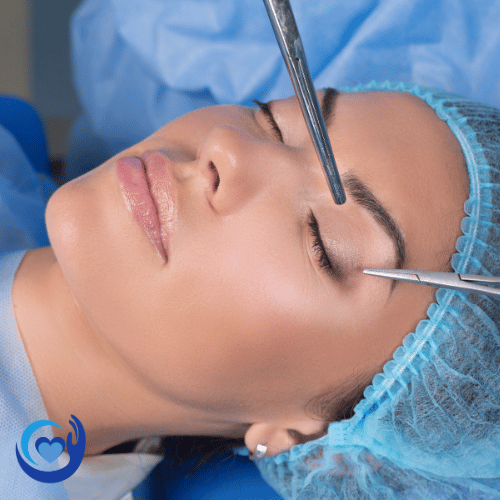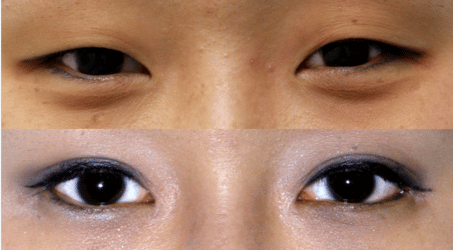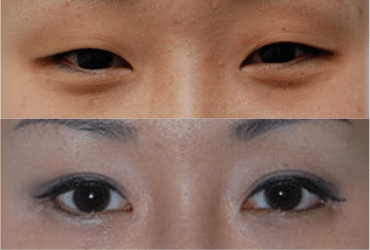Book Appointment Now
Learn More about Eye lifts (aka Blepharoplasty)
Blepharoplasty, or eyelid surgery, involves the removal of excess skin and fat from the upper and lower eyelids to rejuvenate the appearance and improve vision if sagging eyelids obstruct sight. This quick outpatient procedure results in a more youthful, alert look. This normally requires local anaesthetic.

Blepharoplasty can help you with:
- Removing excess skin and fat from the upper and lower eyelids.
- Improving vision if sagging eyelids are obstructing your sight.
- Reducing puffiness and bags under the eyes.
- Creating a more youthful, alert appearance.
You may be a suitable candidate for blepharoplasty if:
- You are physically healthy and have no serious eye conditions.
- You have realistic expectations about the outcome of the surgery.
- You are bothered by drooping upper eyelids or puffy bags under your eyes.
- You are a non-smoker or able to stop smoking for a period before and after surgery.
What Happens During the Procedure?
Your eyelid surgery takes place in our outpatient clinic under local anesthesia with sedation – which means you’ll be relaxed but not fully asleep. Here’s what your surgeon will do:
- Create tiny incisions that hide in your eyelid’s natural creases
- Gently remove any extra skin and fat that’s causing puffiness
- Possibly tighten some muscles if needed
- Close everything up with super-fine stitches
- The whole thing usually takes just 1-2 hours



General Schedule – Standard Package for an Blepharoplasty Procedure
- Before you arrive:
- Online meeting with the in-country advocate who will manage your case and our consulting doctor.
- Referral to one of our specialists, followed by an initial online meeting with them.
- Pre-travel meeting with your in-country advocate to finalize your itinerary.
- Day 1 – Arrival day:
- Arrive in Colombia.
- Welcome at the airport by your advocate.
- Transport to your hotel provided.
- Welcome briefing by your advocate at the hotel.
- Day 2 – Preparation day:
- Meet your advocate at the hotel in the morning.
- Transport to your pre-procedural consultation with your specialist.
- Detailed discussion with your advocate to ensure you are fully prepared for the procedure.
- Day 3 – Procedure day:
- Advocate will meet you at the hotel in the morning.
- Transport to the clinic for your blepharoplasty procedure.
- Post-procedure check-in with your advocate.
- Return to the hotel for initial recovery.
- Day 4 – Recovery day:
- Dedicated recovery day to ensure you are travel-ready and to confirm the success of the procedure.
- Option to engage in light activities if you feel well enough.
- Transport and advocate support available throughout the day for any questions or needs.
- Day 5 – Travel day:
- Advocate meets you at your hotel for transport to the airport.
- Assistance from your advocate through the airport until customs.
What to expect before, during, and after the blepharoplasty surgery?
Before Surgery:
- You will have a consultation with your surgeon to discuss your goals, medical history, and any concerns.
- Pre-surgery instructions may include avoiding certain medications and arranging for someone to drive you home after the procedure.
During Surgery:
- The surgery is usually performed under local anesthesia with sedation.
- The surgeon will make incisions along the natural lines of your eyelids to remove excess skin and fat.
- The incisions will be closed with sutures or surgical tape.
After Surgery:
- You may experience swelling and bruising, which should gradually improve over the first few weeks.
- Follow your surgeon’s instructions on how to care for your eyes and manage any discomfort.
- Use prescribed ointments and cold compresses to aid in the healing process.
- Full recovery can take several weeks, with results becoming apparent as the swelling subsides.
Recovery After Your Surgery
Let’s walk through what to expect as you heal:
First Week
You’ll head home the same day as your surgery. Expect some bruising around your eyes – kind of like a black eye. We’ll give you cold packs to help with swelling, and eye drops to keep your eyes comfortable. Sleep with your head propped up on an extra pillow, and try to take it easy. Most people say it’s more uncomfortable than painful.
Weeks 2-3
The bruising starts fading now (concealer is fine to use at this point!), and most folks feel comfortable enough to return to work. Your eyes might still feel a bit tight or watery – that’s normal. The stitches are usually out by now, and you’re starting to see your new look, though some swelling sticks around.
Month 1
Now you’re getting back to your normal routine. The big changes are visible, but your eyes keep settling into their final shape. You can wear contact lenses again if you use them, and exercise is usually okay. Most people say their eyes feel much more open and bright.
Long-term Results
By 3 months, you’re seeing the full results – eyes that look naturally refreshed, not “worked on.” Those tiny incision lines keep fading until they’re practically invisible. The best part? Results typically last for years, especially if you’re good about sun protection.
- In-country ground transportation,
- In-country concierge service,
- Stay at a comfortable 4 Star Accommodation,
- Consultation and orientation with our in-house doctor,
- Medical Procedure,
- Travel insurance.
FAQs – Here we answer your common questions about Blepharoplasty
The results of blepharoplasty can last for many years. Upper eyelid surgery results typically last about 5-7 years, while lower eyelid surgery results are usually permanent.
Blepharoplasty can significantly improve the appearance of your eyes by removing excess skin and fat, leading to a more youthful and rested look. It can also improve vision if sagging skin was obstructing your sight.
Blepharoplasty is typically an outpatient procedure, so most patients can go home the same day. However, you will need someone to drive you home and stay with you for the first 24 hours.
Initial recovery usually takes about 1-2 weeks. Swelling and bruising should subside significantly within this period, but complete healing can take a few months.
Most people can return to work and normal activities within 7-10 days, depending on the nature of their job and their personal recovery progress.
Blepharoplasty is generally not very painful. Most patients experience mild discomfort, which can be managed with prescribed pain medication.
Blepharoplasty is generally safe when performed by a qualified and experienced surgeon. As with any surgery, there are risks and potential complications, which should be discussed with your surgeon.
Many patients find blepharoplasty worth it due to the significant improvement in their appearance and self-esteem. The decision is personal and should be made after thorough consideration and consultation with a qualified surgeon.
Blepharoplasty does leave scars, but they are typically well-hidden in the natural creases of the eyelids or along the lash line and tend to fade over time with proper care.
The information provided here within should not be construed in any way as medical guidance or advice. Please consult with your medical physical or health provider. Information provided is for informative purposes only and may not capture all pertinent laws, standards, and best practices. The medical field is continually evolving; information mentioned may be outdated and/or could undergo changes. The interpretations presented are not official. Some sections are based on the interpretations or views of relevant authorities, but we cannot ensure that these perspectives will be supported in all professional settings.